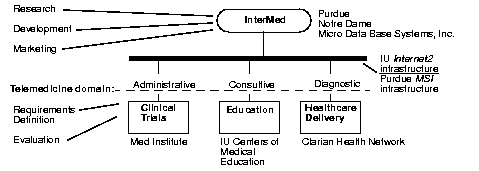|
Intermed
InterMed is
a Distributed Medical Multimedia Database Management System. InterMed will
provide highly marketable functionality that is not available in telemedicine
today. This system will support the following:
-
management
and use of patient medical data in textual, audio, image, and video form
all together in a coordinated fashion;
-
coordinated
capture, transmission, storage, and retrieval of video and cardiac ultrasound
data from remote sites;
-
annotation
of image, audio, and video medical data with textual and audio commentaries
by physicians;
-
use
of content-based retrieval of these data using indexes built using the
annotations; and,
-
the
ability to use of state-of-the-art image and video processing techniques
now in development by two consortium members (Notre Dame and Purdue).
Motivation & Purposes
Managing multimedia data still
presents significant technical problems that consortium members are working
to solve, because they exist in many formats, some formats like video do
not fit naturally into traditional database systems, and the nature of
the data raises serious security and privacy requirements. The InterMed
system will leverage advanced technologies and standards for distributed
object management, medical data representation and interchange, and World-Wide
Web document representation. It will provide more effective exchange of
medical information between health care providers, educators, and clinical
trial laboratories.
The InterMed
demonstration prototype will serve two purposes:
-
Leverage
& Integrate: Research members of this consortium are active in ongoing
research on technologies that will form the elementary building blocks
of advanced telemedicine, but they are not currently funded to perform
technology transfer. This project will allow these results to be leveraged
and integrated into a concrete demonstration prototype application that
serves a specific purpose.
Evaluate
& Market: The demonstration prototype will serve as an incubator of
marketable ideas in health care delivery, clinical trial management, and
educational technology. Deployment of the demonstration prototype will
occur in several operational environments. The purpose of this strategy
is to demonstrate the wider applicability of the solutions. For example,
content-based video retrieval is expected not only to provide a marketable
solution for medical consultation, but also to provide a critical resource
for medical education in Indiana, which can then be marketed to other states.
Project Scope & Team
The general division of responsibilities
among consortium partners is depicted in the figure below. Purdue, Notre
Dame, and Micro Data Base Systems will perform the R&D, and technology
transfer. Med Institute, IU, and Clarian will consult on user and system
requirements, and will trial the prototype. All members will play a role
in commercialization with leadership from consortium members in the Krannert
School of Management at
Purdue.

Figure
Project Scope
Expected Outcomes
Local
economic development: The demonstration prototype developed by the ITI
will contribute to the development of commercial products and services
across Indiana. Specific impacts are expect in three sectors of the telemedicine
industry:
-
improved
access and care products: The technology developed in this project will
allow greater functionality in the practice of medicine to be achieved
remotely. This is particularly important for so-called physician shortage
areas. This improvement includes cost improvements through the legal circumvention
of the costly inter-LATA toll barriers to telemedicine. The demonstration
prototype described in this proposal, for example, will allow richer consultive
and diagnostic functionality to be provided via the Internet2 infrastructure.
These low cost/high functionality solutions will be attractive to the health
care delivery sector of the health care industry.
-
improved
administration products: The demonstration prototype will address problems
of exchanging and integrating the various forms and standards of medical
data, including textual, audio, and video patient records, as well as physician
annotations to those records. The improved ability to manage and exchange
such multimedia medical documents will be attractive to the health care
administration, delivery and clinical trial sectors of the health care
industry.
-
improved
medical distance education products: Medical distance education technology
will be improved by the consultative features of the demonstration prototype.
The development of video database management systems and content-based
video retrieval will allow medical educators to quickly locate and present
to their students video clips of important medical procedures. Annotation
capabilities will allow these video data to be associated with audio and
textual commentaries and notes. This technology will be attractive to the
film and media industries, the digital library community and the distance
education industry around the world, even outside of the discipline of
medicine.
Leveraging
of existing infrastructure: The demonstration prototypes developed by the
ITI will leverage some existing infrastructure in the Indiana, extending
their usefulness and increasing their operational cost/benefit ratios.
The primary infrastructure to be leveraged will be Internet2, multimedia,
and computing facilities in member institutions.
Creation
of unique resources: The demonstration prototype will produce unique resources
for the state of Indiana. The primary unique resource will be a telemedicine
network infrastructure that can be used to deliver telemedicine products
and services to medical schools, health care providers, and clinical trial
managers.
|

